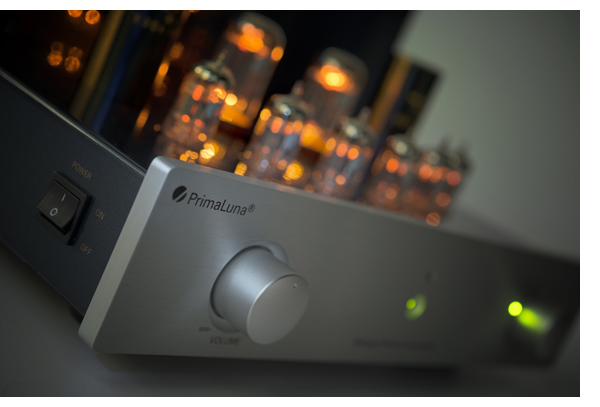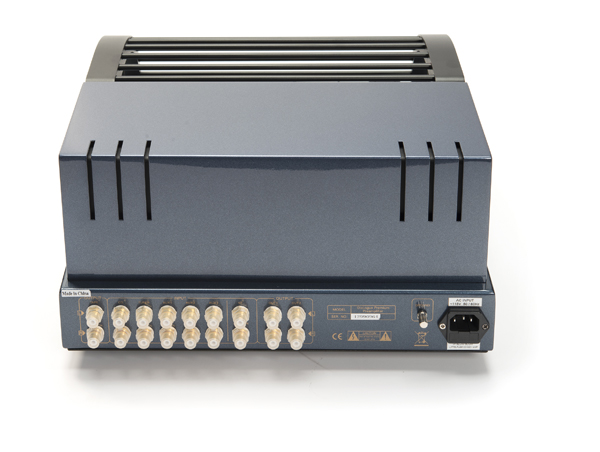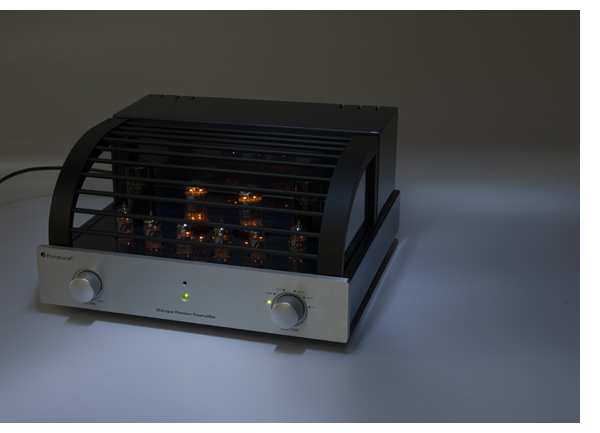 PrimaLuna and I go way back; back before TONEAudio was even a twinkle in my eye back. The first audio review I wrote for The Absolute Sound happened to be the original EL-34 based ProLogue 1, and was way more exciting than the boring NAD integrated amplifier that Robert Harley was going to have me cover for my first assignment. I bought that review sample not only because it sounded great, but it was so much fun; reminding me of all the great EL-34 amps I’d owned over the years. 11 years later it’s still in my family, going strong, with merely one set of replacement tubes – a testament to PrimaLuna quality.
PrimaLuna and I go way back; back before TONEAudio was even a twinkle in my eye back. The first audio review I wrote for The Absolute Sound happened to be the original EL-34 based ProLogue 1, and was way more exciting than the boring NAD integrated amplifier that Robert Harley was going to have me cover for my first assignment. I bought that review sample not only because it sounded great, but it was so much fun; reminding me of all the great EL-34 amps I’d owned over the years. 11 years later it’s still in my family, going strong, with merely one set of replacement tubes – a testament to PrimaLuna quality.
It’s been fun watching TONE and PrimaLuna grow over the years, diversifying our products, but keeping the same ethos of offering high performance at a reasonable price, never giving quality a back seat. PrimaLuna now has a range of four vacuum tube preamplifiers; with the DiaLogue being the top of the range at $3,199.
Where a number of past PrimaLuna preamplifiers relied on the 12AX7 tube, the DiaLogue Premium takes advantage of the 12AU7, six of them – and this has two big benefits. For those not familiar with the brand, PrimaLuna gear has always been super easy on tubes, so investing in a good set of premium NOS (New Old Stock) tubes has always been solid thinking. Fortunately, where the best 12AX7s are now pushing $200 – $350 each, equally good 12AU7s will only set you back about $75 each. And PrimaLuna’s US importer Kevin Deal can hook you up.
You don’t need to invest in NOS tubes if you don’t feel inclined. The DiaLogue Premium sounds great out of the box. Tube rolling is only for those who are part curious, part OCD, and can yield different results for those wanting to chase the rabbit. Most of you will just unbox your DiaLogue Premium and enjoy. There’s nothing wrong with that.
The biggest advantage of the 12AU7 though, is it’s lower gain. With so many of todays sources having a four volt output, the 22 -28db of gain that most contemporary line stages provide is just not needed. You end up with the volume control always being used in the 7:00 to 9:00 position and not only having precious little range of control, but noise can be an issue because the preamp is not running in it’s sweet (and lowest noise) spot.
Less gain, less pain
The DiaLogue Premium, having 10db of gain, gives you plenty of volume control range and is dead quiet throughout. Using it with my Zu speakers (101db sensitivity) and a pair of 845 SET amplifiers, I had the silky smooth silent treatment, even with my ear right up against the ribbon tweeter. When substituting the DiaLogue Premium, for the Nagra Jazz preamplifier in an all Nagra system, thanks to the low gain, the PrimaLuna was quieter than the mighty Nagra, costing three times more.
A dual mono design with five inputs and two variable outputs, the DiaLogue Premium should be able to handle anything you can throw at it, except balanced sources. (You can use an adapter if need be) As a tape enthusiast, I really appreciated the additional, fixed level, buffered tape output to make mix tapes on my trusty Revox. A home theater pass through is also incorporated, for those needing to make the DiaLogue part of a home theater system.
Running the DiaLogue Premium in our main reference system, displacing the $13,000 ARC REF 5SE preamplifier and the $32,000 Robert Koda K-10 was highly insightful. While the big bucks preamplifiers revealed more music and more dynamic slam at the extremes, the mighty PrimaLuna was never embarrassed. Kind of like comparing a Porsche Cayman S to a GT3.
Trying the DiaLogue Premium with about ten different power amplifiers from Simaudio to Burmester again underscored it’s versatility. Only the Burmester 911 Mk. 3 really needed the volume control cranked all the way to get full output. (no doubt because we were using balanced adaptors here, all of the other balanced power amplifiers tried had separate, single ended RCA inputs. That lower gain was a real blessing when using vintage power amplifiers like the Conrad Johnson MV-50, which only need about .6 volts to be driven to full output. FYI, combining this preamplifier with my MV-50 that has had all of the caps upgraded to CJD Teflon was absolutely heavenly, mated with my Quad 57s.
I’ve always found PrimaLuna gear to be a wonderful combination of old and new school design and sonics, yet as you go up the line, the top components in the PrimaLuna line sound more like current vacuum tube electronics, i.e. more linear and neutral, where the entry level pieces sound slightly more vintage. Much of this is due to the beefy power transformers used, combined with premium Takman resistors, SCR foil capacitors and Swiss sourced, silver plated oxygen free copper wiring throughout.
It’s also worth mentioning that the DiaLogue Premium has no problem driving long runs of interconnect cables. Comparing the sound between a 20 foot run of AudioQuest (find cable here) and a one meter pair revealed no difference, and no rolling off of the high frequencies, so those that like having their power amplifier down on the floor close to the speakers, with the rest of their components further away on a rack will be pleased. I had similar luck with cable from Cardas and ALO Audio.

Love that tube
Personally, there is always something special to me about the sound of a preamplifier built around the 12AX7 or 12AU7 tube, they just always seem to paint the sonic picture with a little bit more air and gradation than the 6DJ8/6922 designs do, and feature more sonic gradation between heavy and soft tones than a preamplifier utilitizing the 6H30 tube. Neither is better or worse, just different. A Lotus Elise gets around the curves with a little less effort than a Corvette or a Viper.
I noticed this the most when listening to acoustic music of any kind. Spinning the XRCD of Lee Morgan’s Tom Cat, it was easy to discern the differences in rendition between my vintage ARC SP-11 (6922 design), current REF 5SE (6H30 design) and the Koda K-10. (best solid state I’ve ever encountered) Morgan’s trumpet has more “blat” and slightly more contrast with the REF 5SE, but the cymbals are dreamier, more palpable, and smoother through the DiaLogue Premium.
Going back to some of George Winston’s solo piano records on the Windham Hill label, the pianos decay is equally enticing through the DiaLogue Premium. This is a totally musical preamplifier, always getting out of the way of the presentation, so that you don’t focus on the gear. Not all preamplifiers can do this regardless of price, so this is a home run for the PrimaLuna – and amazing for $3,199.
Each preamplifier brought its own palette to the reproduction, yet the DiaLogue offers an excellent balance, and cohesion to the musical presentation, almost like listening to a full range ESL, rather than a speaker made of woofer, tweeter and midrange. The DiaLogue provides fatigue free listening at its finest, and made for many 12-hour listening sessions without wanting to ever turn the music down.
While the DiaLogue Premium turns in good performance at the frequency extremes, offering solid, defined and tuneful bass response, combined with extended highs that are never screechy, it’s this coherence and ability to nail instrumental tone and texture that makes it so compelling.
The DiaLogue Premium does what tubes do best, providing a dreamy, three dimensional sense of ambiance, giving the listener a healthy dose of “you are there” realism. Eschewing female vocals, I spent a lot of time listening to Johnny Cash, Elvis and Tom Waits through the DiaLogue Premium and I always came back impressed. The soundstage painted is huge, in all three dimensions, making my Dynaudio Eminence Platinum speakers disappear in the room, no small feat.

Rounding the bases
The DiaLogue Premium preamplifier offers incredible sound and value for $3,199. If I were building a system in the $20 – $50k range, I can’t imagine needing to spend more than this for a linestage, provided you didn’t absolutely have to have balanced outputs. The ability to tube roll with ease and modest cost is another big bonus with this preamplifier, allowing the ability to either fine tune the sound, or just play with a different feel.
Best of all in over a decade now, PrimaLuna has not compromised a molecule on build quality. They are still making gear that feels bank vault solid, encased in a dark blue, high gloss metallic finish that would do an Aston Martin proud. (and a set of cotton gloves to keep fingerprints off of said finish) Even the shipping cartons are the best in the business, with three layers of heavy cardboard to make sure your purchase arrives without blemish.
Combining all of these small touches and world class sonics, makes for gear that owners don’t want to part with. Perusing Audiogon or EBay rarely reveals used PrimaLuna gear, and when it does go for sale, it fetches top dollar. Another home run from PrimaLuna!
PrimaLuna DiaLogue Premium Preamplifier
MSRP: $3,199
PERIPHERALS
| Digital Source | dCS Vivaldi Stack |
| Analog Source | AVID Acutus Reference SP/TriPlanar/Lyra Atlas |
| Phonostage | ARC REF Phono 2SE |
| Power Amplifiers | PrimaLuna DiaLogue Premium Power Amplifiers Burmester 911 mk. 3 Conrad Johnson MV-50C1 Nagra 300B Pass Xs300 Pass Aleph 5 |
| Cable | Cardas Clear |
| Speakers | Dynaudio Eminence Platinum, Acoustat 2+2, KEF Blade |


















